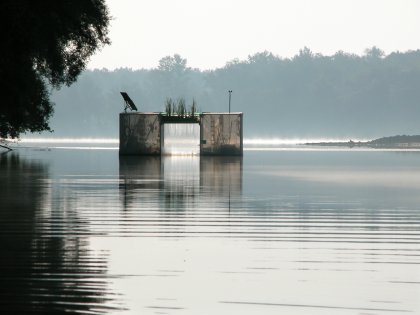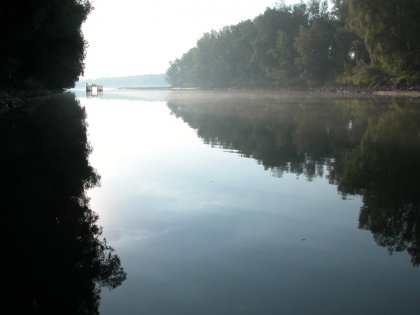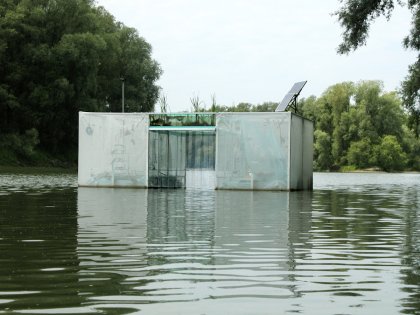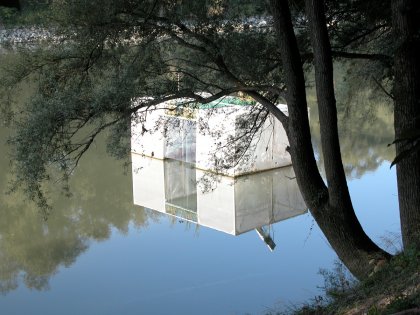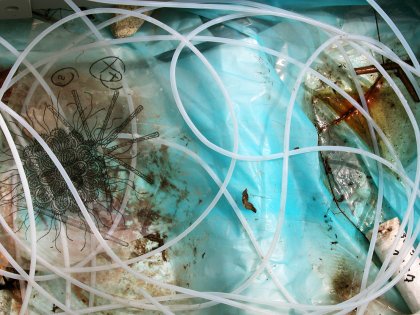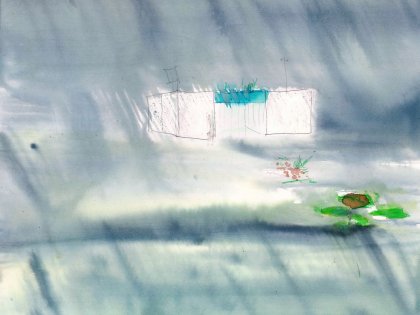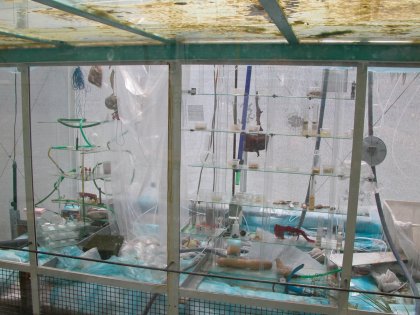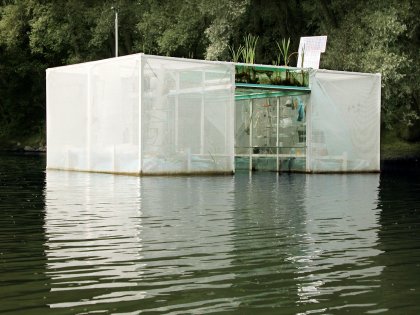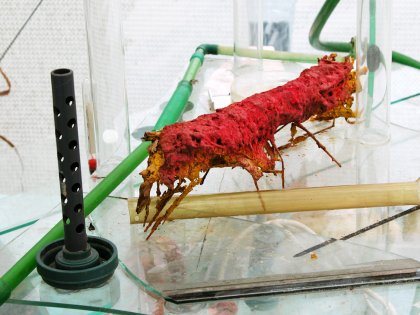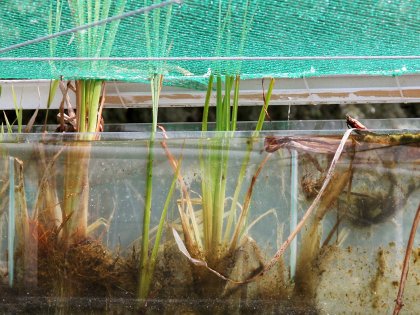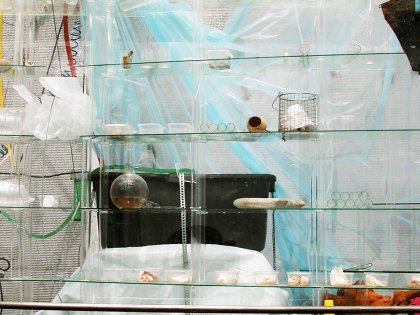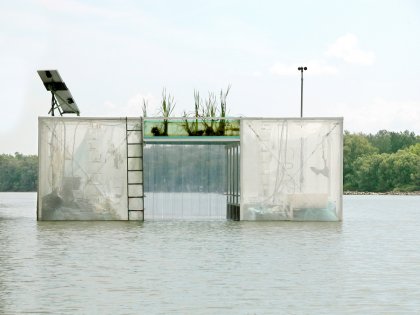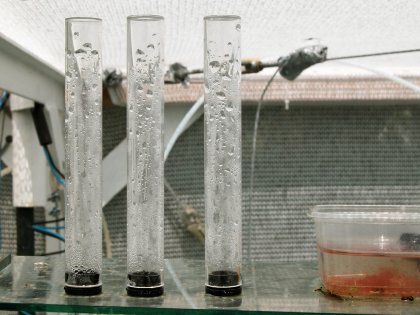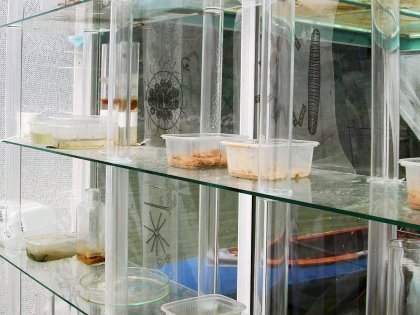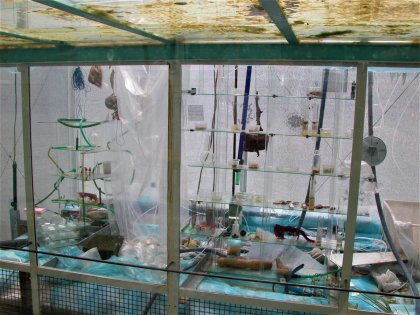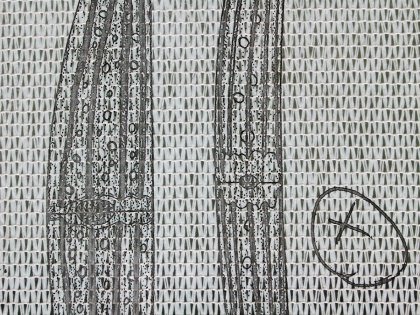Temporary River Laboratory
2003 | Galerie im Fluss | Donau Altarm bei Hütting / AT
Kurator: Christian Geirhofer, Thomas Stöckl
Fotos: Gusenbauer / R.H.
Galerie im Fluss participating Artists:
Peter Rösel, Nadine Rennert, Thomas Hoke, Manfred Erjautz, Fabrizio Crisafulli, Alois Lindenbauer, Wilhelm Scherübel, Norbert W. Hinterberger, Tragut Bernard, Markus Lindinger
temporäres Flusslabor in der Donau
Rolf Hinterecker interessiert sich bereits seit langem für die Schnittstelle von Wissenschaft und Poesie, Natur und Kultur. Sie markiert den Mittelpunkt seiner künstlerischen Forschung, die das Sinnbild für eine neugierige, experimentierende, in eine offene Zukunft gerichtete Lebensperspektive ist.
All das bestimmt auch sein temporäres Flusslabor. Mitten in einer Donauaue schwimmend, verankert mit einer Stahl- und Glaskonstruktion auf zwei Pontons gebaut, ist der große Kubus von außen mit einer netzartigen Transparentumhüllung bespannt. Das macht ihn geschlossen und doch durchsichtig, lässt ihn massiv und zugleich überraschend leicht erscheinen. Vom Ufer aus, aus der Ferne, sieht sein Kunststück wie ein vom Hochwasser fortgespültes, unbekanntes Gebäudeteil aus. Es ist ein Ort, von dem eine seltsame Magie ausgeht, an den sich Fragen und Phantasien anknüpfen, und der unweigerlich das Verhältnis von Natur und moderner (Wissenschafts-) Kultur berührt. Im besten Sinne der traditionellen Land-Art „nutzt“ Hinterecker die Schönheit und das einzigartige Energiepotential der Natur nicht nur als dekorativen Hintergrund für eine skulpturale Inszenierung, sondern Landschaft und Natur werden vielmehr in ihrer ganzen Komplexität selbst zum Gegenstand seiner Kunst.
Wer mehr verstehen will, muss mit dem Boot hinausfahren, wie Entdecker sich einst über das Wasser zu unbekannten Inseln aufmachten. Man kann mit dem Kanu durch die schwimmende Skulptur hindurchfahren. Man kann sich um sie herum bewegen. Und man kann durch gläserne Sichtfenster in sie hineinsehen: auf eine Anordnung verschiedenster Laborgegenstände, Regale voller Untersuchungsmaterialien (etwa Fundstücke aus dem Fluss und der nahen Umgebung), elektronenmikroskopische Aufnahmen von Plankton und unterschiedlichste, vom Künstler angesetzte Pflanzenkulturen, die sich im Laufe der Monate entwickeln sollen. Gegenstände mit tatsächlicher Funktion und Phantasieobjekte gehen in diesem Labor untrennbar ineinander über. Dem entspricht, dass neben der poetisch-träumerischen Dimension auch ganz konkret mit dem Labor gearbeitet wird. Die Schüler zweier Projektgruppen beobachten die Veränderungsprozesse, protokollieren Pegelstands- und Temperaturmessungen und die Wachstumsauffälligkeiten der Pflanzen. Die Vernetzung mit sozialen Projekten ist inzwischen ein fester Bestandteil der meisten künstlerischen Arbeiten Hintereckers. Seine Kunst will ein Band spannen zwischen sozialen und ökologischen Lebensgrundlagen und zum Ausdruck bringen, dass das eine untrennbar auf das andere bezogen werden muss. Das Andere ist die Verortung seiner Kunst in der Natur.
Fünf Monate soll das Kunstwerk sich selber überlassen sein und in dieser Zeit sein Potential entwickeln. Es wird sich verändern. Es wird rosten, überwachsen, Tiere werden sich einschleichen wie in ein Wrack, das am Uferrand im Wasser liegt. Und gerade durch diesen offenen Wachstumsprozess erhält das Kunstwerk eine ganz besondere Dramatik und Schönheit.
Bereits seit längerem produziert Hinterecker nicht unbedingt abgeschlossene Kunstwerke, sondern setzt künstlerische Prozesse in Szene. So will seine Kunst den endlosen Zusammenhang von Morbidität und Wachstum, Auflösung und Aufbau, Leben und Sterben zeigen, der grundsätzlich alles Dasein seit Urzeiten bestimmt. Und dem kommt sie am nächsten, wenn sie sich selber in diese Prozesse einschmiegt und Teil von ihnen wird.
Das schließt den Kreis wiederum zu den neusten wissenschaftlichen Forschungen der Biologie und Chemie, die nichts anderes machen und damit der Natur zugleich eine (neue) Drehung geben. Hintereckers Faszination an den zeitgemäßen wissenschaftlichen Zauberküchen ist dabei ebenso groß wie sein Respekt vor dem gewaltigen, undurchsichtigen Zusammenhang der Natur. Und damit schlägt er eine Blickrichtung ein, die zu thematisieren die moderne Kultur bislang immer noch größtenteils ausweicht. Jürgen Kisters,
Temporary River Laboratory
Rolf Hinterecker has long been interested in the interface between science and poetry, nature and culture. It marks the centre of his artistic research, symbolising an inquisitive, experimental perspective on life with an uncertain future.
All of these factors also define his temporary river laboratory, smimming and anchored in the middle of a branch of the Danube. This steel and glass construction has been built on two pontoons and the larger cube is covered on the outside by a netlike, transparent wrapping. This makes it closed yet transparent, makes it appear solid and at the same time surprisingly light. Viewed from a distance, the river bank, his work of art looks like some part of an unknown building that has been washed away by a flood. It is a place that exudes a rare sort of magic, that gives rise to questions and fantasies, where the nature inevitably comes into contact with modern (scientific) culture. In the true sense of traditional Land-Art, Hinterecker “uses” the beauty and unique energy potential of nature not only as a decorative backdrop for a sculptural production, rather the landscape and nature themselves become part of his art in their entire complexity.
Anyone who wants to know more has to take a boat out to the work of art, just like explorers of yore setting sail for unknown islands. You can paddle through the sculpture in a canoe. You can move around it. And you can peer inside through glass viewing windows: onto an arrangement of various laboratory instruments, shelves full of examination materials (for example findings out of the river and the nearby surroundings), electron-microscope pictures of plankton and various plant cultures prepared by the artist that should develop over the months. Objects that actually serve a purpose and fantasy objects are inseparably entwined in this laboratory. This is in agreement with the fact that apart from the poetic-dreamlike dimension, actual work is being carried out with the laboratory. Pupils from two project groups will monitor the processes of change, record water level and temperature measurements and any unusual growth of the plants.
A combination with social projects has in the meantime become a fixed part of the majority of Hinterecker’s artistic work. His art wishes to provide a link between basic social and ecological living conditions and demonstrate that the one is inseparably related to the other. The other aspect is the locating of his art in nature.
This work of art will be left to its own devices for five months and develop its full potential over this period. It will change, rust, become overgrown, animals will take up house like in a shipwreck stranded near the river bank. And it is precisely this open growth process that gives the work of art a very special drama and beauty.
For a long time now, Hinterecker has not necessarily been producing completed works of art, but staging artistic processes. His art attempts to show the endless connection between morbidity and growth, destruction and construction, life and death, that has formed the basis of all existence since time immemorial. And these works of art come closest to this if they themselves melt into this process and become part of it.
This in turn brings us full circle to the latest scientific research in the fields of biology and chemistry, that in turn do nothing else and thus give nature a (new) twist. Hinterecker’s fascination for contemporary scientific laboratories is just as great as his respect for the enormous, obscure relationships in nature. So that his outlook on things is one that modern culture is still to a large extent wary of picking out as a central theme. Jürgen Kisters, June 2003
Technische Daten
Größe / Grundriss 6 m x 4 m, Höhe ca. 2.40 m über dem Wasserspiegel.
Materialien:
Rahmenkonstruktion: Stahl / Standardprofile geschweißt u. verschraubt.
Pontons: Polyester-Fiberglas
Außenverkleidung: Gerüstnetz Nylon - weiß
Wasserbecken: 8mm und12mm ESG Sicherheitsglas mit Silikon verklebt im Stahlrahmen.
Weitere Materialien: Schläuche / Folien / diverse Laborgeräte Wannen /Glas/Folien
Fundstücke / Spuren weiterer Forschungsprojekte
Versuchsprobanten: / Gnome in verschiedenen Entwicklungsstadien diverse Wasserpflanzen Wetterstation / Aufzuchtbecken für Wasserpflanzen / Wasserpumpe: Energieversorgung durch Solarkollektor Photovoltaiksystem 40w
Gesamtgewicht: ca. 4 Tonnen
Verankerung: Donauaue bei Hütting Österreich
Realisierung und Unterstützung durch die Firmen Biberauer (Pontons) aus Grein (A) und Baumann aus Baumgartenberg (A)
Statik: Büro Günter Christl Lindlar bei Köln
Weitere technische Beratung und Hilfe :
Günter Ziffus (biologische Beratung D, Architekturbüro Dagmar Ditzer (Planung) D , Thomas Guesnet (Schiffsbau) D, Cheesy aus Köln D, Wolfgang Leitner(Glasbau) A Glaserei Ritter D, Dieter Decker u. Rudolf Zarl (beide Metallbau) Á
Besonderer Dank Dr. Waltraud Dennhardt-Herzog A , Knopp Ferro D, Fam. Moser und der Feuerwehr von Mitterkirchen, Hildegard Hinterecker D, Walter Hinterecker A, u.v. and.
Size / floor plan 6 m x 4 m, height approx. 2.40 m above water level.
Materials :
Frame construction: steel / standard profiles welded and bolted.
pontoons: Polyester-fibreglass
Outer cladding: Scaffold net Nylon white
Water basin: 8mm and 12mm ESG safety glass with silicone glued in the steel frame.
Other materials: Tubes / foils / various laboratory equipment Tubs / glass tubes /
foils / finds / traces of further research projects
experimental probands: / gnomes in different stages of development / various aquatic plants
Weather station / breeding tank for aquatic plants / water pump
Energy supply by solar collector photovoltaic system 40w
Total weight: approx. 4 tons
Anchoring: Danube floodplain near Hütting in Austria
Realisation and support by the companies Biberauer (pontoons) from Grein (A) and Baumann from Baumgartenberg (A)
Statics: Günter Christl Lindlar office near Cologne
Further technical advice and assistance :
Günter Ziffus (biological consulting D, architecture office Dagmar Ditzer (planning) D , Thomas Guesnet (shipbuilding) D, Cheesy from Cologne D, Wolfgang Leitner (glass construction) A Glaserei Ritter D, Dieter Decker and Rudolf Zarl (both metal construction)
Special thanks to Dr. Waltraud Dennhardt-Herzog A, Knopp Ferro D, Moser family and the fire department of Mitterkirchen, Hildegard Hinterecker D, Walter Hinterecker A, and many more.
